POETS Young Scholars Find Sun Buckets Summer Research Experience Meaningful
“You don't go into a summer program thinking you'll get job experience, as well as knowing what you want to do in the future, as well as learning basic skills like problem-solving.” – Jasmine O’Connor
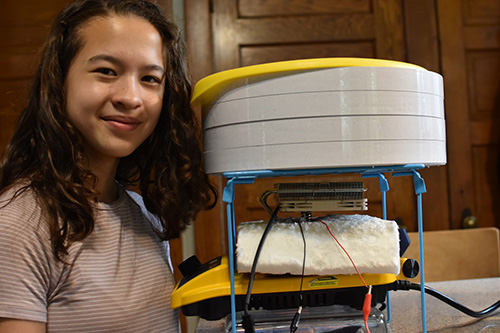
Lily Weaver tests the Sun Bucket's effectiveness for drying various fruits and grains. (Image courtesy of Lily Weaver.)
August 27, 2020
Two Champaign Central High School students, Jasmine O’Connor and Lily Weaver, spent the summer socially distancing yet doing research that could make a difference for folks around the world. Part of the NSF-funded POETS (Power Optimization for Electro-Thermal Systems) Engineering Research Center’s Young Scholars program, the two used Sun Buckets technology, which harnesses the power of the sun to use in cooking, to conduct research about drying a variety of common foods. In addition to learning a whole lot about how Sun Buckets work, they gained confidence, plus skills in problem solving and time management. The two also learned how to present research—then actually did so at POETS' virtual end-of-the summer final poster session. Plus, both gained a much clearer understanding of what careers they might be interested in pursuing in the future.
To understand these Young Scholars’ research project, one needs to understand what Sun Bucket is and how it operates. Particularly intended for low-resource communities, it’s an efficient cooking device that absorbs solar energy and concentrates it to use for cooking. Sun Buckets CEO Bruce Elliott-Litchfield describes it like this:s
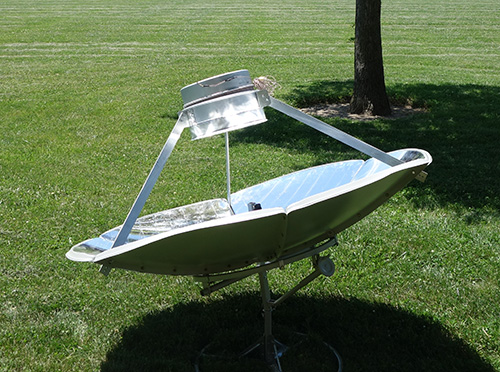
A Sun Bucket atop a five-foot parabolic dish soaks up solar energy. (Image courtesy of Joe Bradley.)
"Sun Buckets store heat in a portable container, so you can cook when and where you like, even inside and at night. The cooking surface is a simple flat metal plate, so you can use your own pots and pans." (Evidently with some other solar cookers, one has to cook in a box or a tube.)
Before the two high school researchers could concentrate on their research project, how to dry foods using Sun Bucket technology, they first had to understand how it works.
The Sun Bucket can be heated up using a parabolic dish that concentrates sunlight, or a hot plate that uses energy from solar photovoltaics or any other sources. According to Elliott-LItchfield, "When the concentrated sunlight shines on the surface of the Sun Bucket, it heats the bucket and the contents, a salt that changes from a solid to a liquid and thereby stores lots of heat in a small volume." He says the Buckets generally heat to about 350C ("because that temperature can emulate frying, fast boiling, etc."), which can last from 6 to 16 hours. Sun Buckets are currently being distributed and manufactured worldwide.

Jasmine O'Connor dries food as part of her POETS Young Scholars summer research project. (Image courtesy of Jasmine O'Connor.)
Regarding the girls’ project, using the Sun Bucket to dry food, according to Joe Bradley, a Bioengineering Assistant Professor involved with both the engineering and the business side of the start-up, it got its roots in a previous project: Could a device be set on top of the Sun Bucket plate after it's been heated and somehow circulate air through a column in order to dry peanuts?
Understanding why being able to dry foods with the Sun Bucket is relevant was also an extremely motivating factor for the girls. The project had to do with post-harvest loss and helping farmers in regions Sun Buckets is targeting dry their products. Bradley describes a scenario: “They might just sit them on the ground and put a towel out,” Bradley explains, “and then you get a big loss. Either rodents come eat your product. or your product goes bad, or something happens. So it wasn't an effective way to dry it.” So Sun Buckets wants to help farmers dry their product more efficiently, which will allow them to then take it to market and sell it. “So we want to make the use of the Sun Bucket as a dryer available in the future as well,” adds Bradley.
A key player in the POETS Young Scholars Sun Buckets team was Tom Gelsthorpe, a Central High chemistry teacher who has worked with Young Scholars for the last three summers, supporting small teams of students doing summer research. For summer 2020, Gelsthorpe dropped supplies off at the students' houses, and they met a couple of times a day online. In fact, this summer, the three only met up once in person—on Lily Weaver’s lawn. “So, we all sat at opposite corners of the lawn and kind of talked there at one point,” Gelsthorpe recalls. And though he sometimes helped them troubleshoot things, suggesting, “All right, here's how we can do this,” he says that “In a lot of cases, they were able to figure it out kind of between each other. So, they worked really well together. Jasmine and Lily did a great job of figuring everything out.”
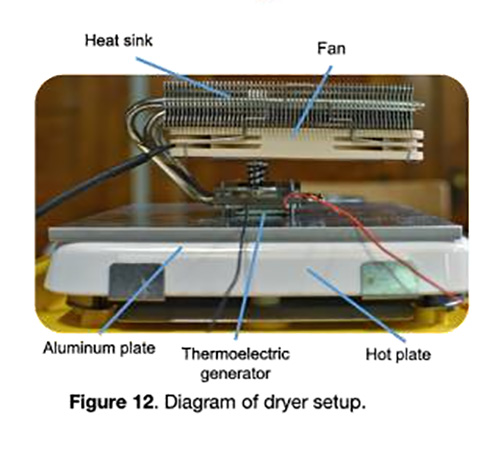
Taken from the students' final presentation, this is an image of the dryer setup the two used to dry the various foods.
One perk of the project, according to Gelsthorpe, was the privilege he and his students had of interacting with the startup’s team. “So now we're in on Sun Buckets’ worldwide meetings every Thursday morning—we're part of the company Zoom. You have people calling in from Kenya, and from India, and from Urbana.”
Does this opportunity make his students feel that what they're doing is significant—that it's going to make a difference? Gelsthorpe says yes.
“I think they're really appreciating how awesome an opportunity that is,” he admits. “You're 15 or 16, and here you are, at this worldwide company’s big meeting for the week where you're checking in, you're delivering your report. So, it's a really awesome opportunity for them to get this chance so early on.”
In fact, their team gives a weekly report at those meetings, and Gelsthorpe has encouraged the girls to take the lead on delivering those reports. He’s told them, “Hey, the way you're going to get comfortable with this is you just try it out. If they didn't want you here, they wouldn't have invited you. You are welcome here, and you're contributing; you're doing something cool. You're showing off this extra capability of what their product can do.”
Elliott-Litchfield says, "It was delightful having Lily and Jasmine working with us this summer. They and their advisors normally joined our weekly global team meetings and gave reports of their progress, plans, and needs. As you know, they focused on the use of Sun Buckets to operate as an off-grid food dryer." Plus, he and his team found the two students' work helpful. "The Young Scholars were able to broaden the application of the Sun Buckets food dryer to include several foods we had not tested yet, so they were very helpful to us," Elliott-Litchfield reports.

Jasmine O'Connor, a rising junior at Champaign Central High School. (Image courtesy of Jasmine O'Connor.)
In addition, Gelsthorpe’s students have gained an overall confidence that’s been transferred to other areas, which he calls “really cool.” He shares a short anecdote about how Jasmine O'Connor “was speaking up," explaining, "So, there was a meeting today with Women in Engineering at Illinois, and she talked about her experience a little bit. But there's just this confidence, and she's just willing to step up and express everything that's going on.”
Agreeing with Gelsthorpe about how beneficial the Young Scholars program has been for her, Champaign Central High rising junior Jasmine O’Connor shares why she got involved. She reports that Gelsthorpe was asked to find applicants, thought she'd be a good fit for the program, and sent her an email. “I was like, ‘I'm so excited!’ she recalls, “because I was really trying to find a summer program in which I could continue to learn.” O’Connor indicates that due to COVID, a lot of the summer programs to which she had previously applied and gotten into had been canceled. “The POETS program was the only opportunity,” she continues, “and it ended up being like the best opportunity ever.”
O’Connor says that although she had done research projects on certain topics at school, she’d never done something of this type, to this degree of hands on. “We were really allowed to take liberty with the thing we wanted to do—the things that we wanted to test. And it was really crazy, because we were leading the experiments. It wasn't like a teacher was giving us the set guidelines, and we would have just had to complete this checklist. It was really a kind of, ‘Go do your own experiment!’”
O’Connor calls their research “application of Sun Bucket kits to thermoelectric generators to create a dryer,” then test drying a lot of different foods. For instance, they dried corn, which looked amazingly like Kellogg’s’ cornflakes.
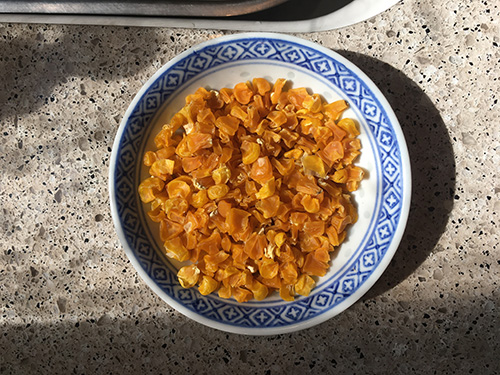
Corn flakes dried as part of their summer research. (Image courtesy of Lily Weaver.)
Where did the two get the ideas of which things to try to dry? Did they just come up with those on their own? O’Connell says they had a lot of encouragement regarding what things to try based upon what others, such as Sun Bucket creators Bruce Elliott-Litchfield and Matt Alonzo, had already done. So, the two mainly focused on fruits and grains—products most likely grown by the farmers in areas in India and Africa that they were trying to aid with this dryer. For instance, they dried beans, chickpeas, bananas, grapes, and tomatoes.
So did O’Connor taste the dried bananas, and, if so, how were they? “Yes, I actually did,” she admits. “They were actually pretty good.” She added that they weren’t exactly like the banana chips one can purchase in the store, explaining that those have been deep fried first. “And obviously, we were just trying to see how efficient our dryer could be without the added deep-frying type situation, but they still got very close to that, which was very exciting.”
A big part of the experience was that the students learned a lot about how the technology works. “As I said earlier, it was a very hands-on, ‘It's your turn to take the wheel!’ kind of experience. And so he [Gelsthorpe] gave us a box with some thermoelectric generators, the heat sink, and a metal plate and some screws, and he said, ‘Here you go; use the resources you have.” By collaborating, the two were able to use their knowledge of what a thermoelectric generator is, and how it has the hot side and the cold side, and how that had to interact with their hot plate, which simulated a Sun Bucket. From that, they were able to create a successful dryer.
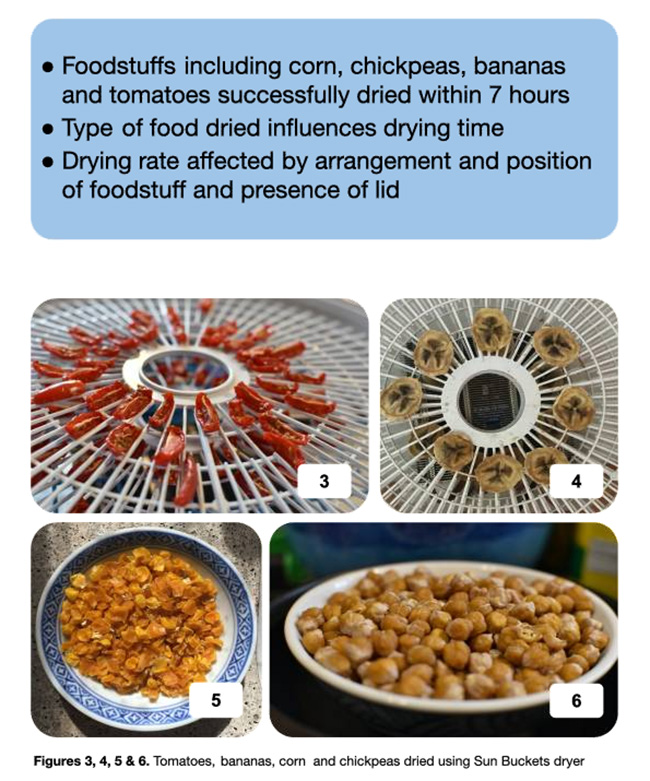
A slide presented during POETS' final poster session showing various fruits and grains Jasmine O'Connor and Lily Weaver dried as part of their research.
So, what did O’Connor’s mom and dad think of all this? She says her parents were like, “You have a whole laboratory inside your room! It's kind of crazy!” She adds that “It was also really exciting, because I think they also got to learn as well!” She reports that they would come into her room, asking, “‘What are you doing today?’ And I'm like, ‘Oh, I'm drying, blah, blah, blah.’ It was really exciting for them; it was kind of like a family experiment, you know?”
O’Connor indicates that she learned a lot that might help her down the road: “Perseverance is a big one. And I think just the entire process of how to run an experiment or how to have that self-accountability and the problem solving. I would say problem solving is probably the biggest thing, because we ran into a lot of problems with the work we were doing, but then we always worked together, or even independently, to get to an outcome.”
Regarding how O’Connor, whose favorite subject in school is math, believes her summer research experience might have impacted her plans for the future, now, more than ever, she thinks she might be interested in doing research. “Even before I had the summer program,” she explains, “I was interested in it [research], and I knew I wanted to do cancer research or work in a STEM or a medical field. But doing this experiment in the summer program has grown my love for research, and experiments, and kind of this hands-on type of career.”
Regarding all that she’d gained during the summer that she hadn’t expected, O’Connor says “That's all so crazy, because you don't go into a summer program thinking you'll get job experience, as well as knowing what you want to do in the future, as well as learning basic skills like problem-solving.”
Expressing her gratitude for the entire experience, O’Connor adds: “I just like to say I'm so grateful that this has brought me here. I'm so thankful that you even get the time to reach out, to talk to us. And I'm just so grateful for everybody at the UI and our teachers, who are really still working so hard for this time, which is crazy.”

Lily Weaver, a rising junior at Champaign Central High School. (Image courtesy of Lily Weaver.)
Also a rising junior at Champaign Central, Lily Weaver shares how she got involved with young scholars. As with O’Connor, Gelsthorpe also contacted her, asking, “Do you want to do this program? It seems like a really great opportunity.” She reports, “So I was actually super excited to do it, ‘cause I didn't have any other summer plans.”
Weaver’s folks also appreciated her involvement in Young Scholars…with one caveat. She admits, “They were really happy about it, ‘cause they thought I was just going to be lounging around all summer…So they were happy that I was doing this—although they might've been a little annoyed that I took over the kitchen with this setup. “
Indicating that this was her first time doing research, Weaver particularly enjoyed the autonomy of the experience, of getting to direct the experiments. “Being able to guide them, to have so much say in what we're doing and studying, and what direction we take the project in.”
Regarding the drying experiments, Weaver says Sun Buckets had been working on having a dryer attachment for the solar cooker. So, she and her teammate started thinking, “What foods are good to dry? and then also, "What foods do they like in a lot of other countries? What foods are very commonly dried?" Like O’Connor, her favorite of all that they dried, in terms of taste, was probably the bananas. (She felt the chickpeas had a bitter taste.)
Weaver says her favorite aspect was: “I think maybe getting to be a part of the Sun Buckets team, and learning about how they run their business, and getting to be a part of their business meetings. And it was a cool feeling to feel like you're contributing to what they're doing.” She adds, “And yeah, I guess it was very nice ‘cause it was very hands on.”
She also felt she gained some skills and grew through this experience. “I worked a lot on independence and time management, ‘cause we had a lot of autonomy in this project, so we got to decide when we wanted to do things, and how we were going to do them.” Like her teammate, she also gained a lot of problem-solving skills. “So, when we had a problem, we couldn’t just call Mr. Gelsthorpe over and be like, ‘Hey, can you help me solve this?’ I had to think about it on my own a lot. So problem solving. And also, there's no one else managing my schedule. I had to do it myself, which was somewhat the same before, but it's more complicated with Zoom and online stuff.”
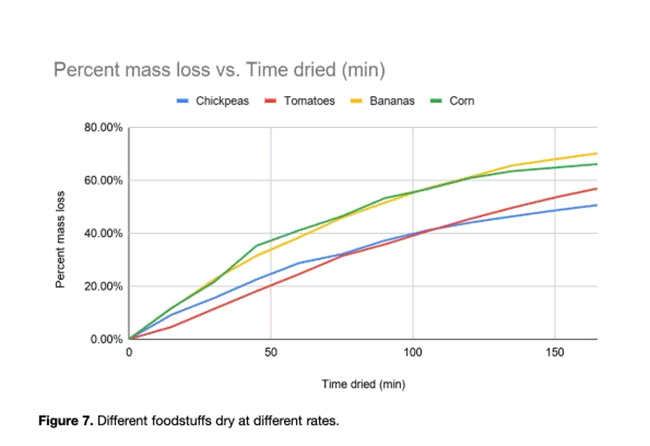
A chart shown by the two ladies during POETS' final poster session comparing percent of mass lost vs. drying time for four different foods: chickpeas, tomoatoes, bananas, and corn.
Plus, Weaver also gained some everyday skills she thinks might come in handy in the future. “Well, very practically, I learned how to strip wires using scissors. So, if I were in engineering now, it'd be useful..”
Weaver also felt her experience might have an impact on her choices down the road, career wise. “I'm not sure yet, but I definitely will think about going to Illinois to major in engineering or something like that. It made me definitely consider engineering as maybe a career or something to study.”
In addition to all the personal benefits and skills gained, Weaver also found it to be very satisfying, knowing that she might be contributing to something that's going to help other people. “This was really rewarding for me, she admits. “I definitely feel like I got a lot out of it, and also knowing that you're contributing to something that will maybe help people. Being able to have that experience, especially so early on, it was really rewarding for me.”
The two students weren’t the only ones who benefitted from the program. Gelsthorpe also found the summer to be extremely rewarding. He claims one of the benefits of working with POETS Young Scholars was, “I get to learn new skills. So, this summer, I've learned definitely some phenomena that I had never seen before. And I wasn't really aware of Sun Buckets. I didn't really know how solar storage was working until this.”
Of course, what he really enjoyed was working with the students and watching them grow. “Getting involved and helping these students see what possibilities are out there, that part is really awesome and really rewarding…Seeing them grow in their skills as the summer goes along and their confidence—that part is extremely rewarding.”
Story by Elizabeth Innes, Communications Specialist. Images by Elizabeth Innes unless otherwise noted.
For additional articles about POETS, see:
- POETS' Young Scholars Program Attracts High Schoolers to Research
- Local 8th Graders Build Solar Cars Courtesy of new POETS' RET Curriculum
- POETS Seeks to Change the Attitudes, Shape of Students in the STEM Pipeline
- POETS, New NSF Center at Illinois, Poised to Revolutionize Electro-Thermal Systems
- POETS website
More: POETS, High School Research , 2020
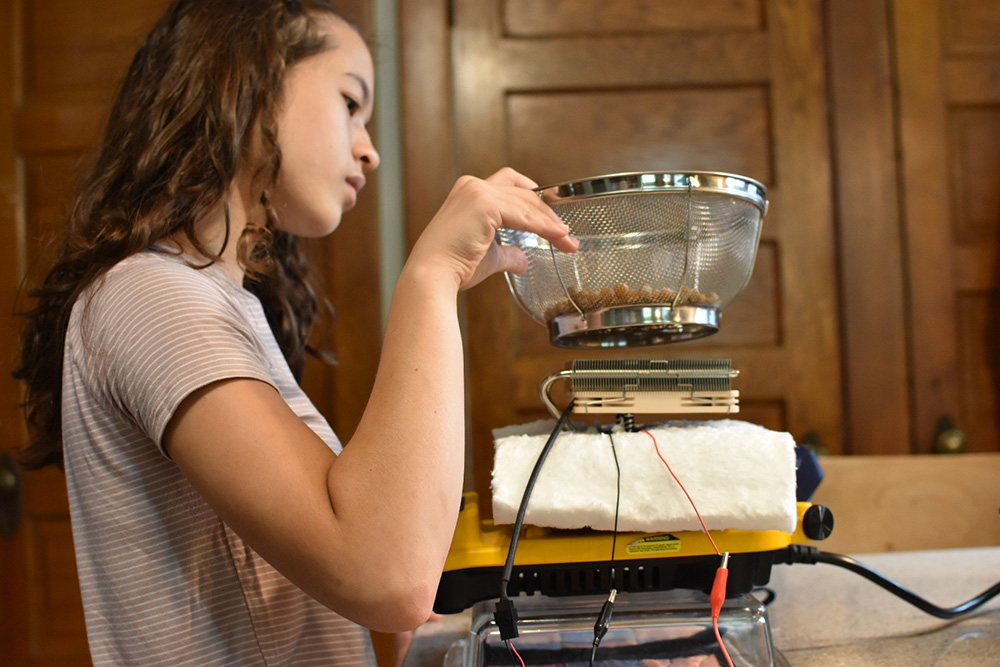
Lily Weaver dries chickpeas as part of her Sun Buckets food drying research. (Image courtesy of Lily Weaver.)













.jpg)
















